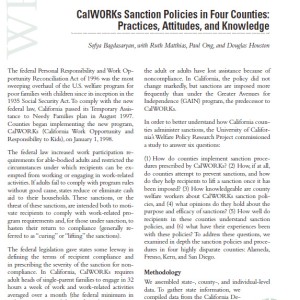
Authors: Sofya Bagdasaryan, Ruth Matthias, Paul Ong, Douglas Houston
Date: May 1, 2005
Project: [wpv-post-link id=”$project”]
The federal Personal Responsibility and Work Opportunity Reconciliation Act of 1996 was the most sweeping overhaul of the U.S. welfare program for poor families with children since its inception in the 1935 Social Security Act. To comply with the new federal law, California passed its Temporary Assistance to Needy Families plan in August 1997. Counties began implementing the new program, CalWORKs (California Work Opportunity and Responsibility to Kids), on January 1, 1998.
The federal law increased work participation requirements for able-bodied adults and restricted the circumstances under which recipients can be exempted from working or engaging in workrelated activities. If adults fail to comply with program rules without good cause, states reduce or eliminate cash aid to their households. These sanctions, or the threat of these sanctions, are intended both to motivate recipients to comply with work-related program requirements and, for those under sanction, to hasten their return to compliance (generally referred to as “curing” or “lifting” the sanctions).
The federal legislation gave states some leeway in defining the terms of recipient compliance and in prescribing the severity of the sanction for noncompliance. In California, CalWORKs requires adult heads of single-parent families to engage in 32 hours a week of work and work-related activities averaged over a month (the federal minimum in order to count toward the state’s work participation rate requirement is 30 hours). As under prior law, California imposes partial-family sanctions: a reduced cash grant to children in families in which the adult or adults have lost assistance because of noncompliance. In California, the policy did not change markedly, but sanctions are imposed more frequently than under the Greater Avenues for Independence (GAIN) program, the predecessor to CalWORKs.
In order to better understand how California counties administer sanctions, the University of California’s Welfare Policy Research Project commissioned a study to answer six questions: (1) How do counties implement sanction procedures prescribed by CalWORKs? (2) How, if at all, do counties attempt to prevent sanctions, and how do they help recipients to lift a sanction once it has been imposed? (3) How knowledgeable are county welfare workers about CalWORKs sanction policies, and (4) what opinions do they hold about the purpose and efficacy of sanctions? (5) How well do recipients in these counties understand sanction policies, and (6) what have their experiences been with these policies? To address these questions, we examined in depth the sanction policies and procedures in four highly disparate counties: Alameda, Fresno, Kern, and San Diego.
Link to Publication